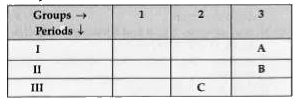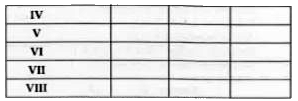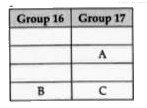The position of three elements A, B and C in the periodic table are shown below :


Give reasons to explain the following:
(i) Element 'A' is a metal.
(ii) Element 'B' has larger size than 'C'.
(iii) Element 'C' has a valency - 3. Solution in Kannada
(i) Element .A. is a metal because it is present in group I (1 valence electron) and can lose electron easily.
(ii) Element B has larger size than .C. because it has more number of shells than .C..
Also, B lies in the third period and has three shells whereas B lies in second period and has two shells.
(iii) .C. being an element of 3rd group has three valence electrons, therefore its valency is 3.
Topper's Solved these Questions
- BOOK - OSWAAL PUBLICATIONCHAPTER - PERIODIC CLASSIFICATION OF ELEMENTSEXERCISE - TOPIC:2- LONG ANSWER TYPE QUESTIONS5videos
PERIODIC CLASSIFICATION OF ELEMENTS
- BOOK - OSWAAL PUBLICATIONCHAPTER - PERIODIC CLASSIFICATION OF ELEMENTSEXERCISE - NCERT CORNER -INTEXT QUESTIONS13videos
PERIODIC CLASSIFICATION OF ELEMENTS
- BOOK - OSWAAL PUBLICATIONCHAPTER - PERIODIC CLASSIFICATION OF ELEMENTSEXERCISE - TOPIC:2-SHORT ANSWER TYPE QUESTIONS-I25videos
PERIODIC CLASSIFICATION OF ELEMENTS
- BOOK - OSWAAL PUBLICATIONCHAPTER - METALS AND NON-METALSEXERCISE - NCERT CORNER (Textbook Exercises)16videos
METALS AND NON-METALS
- BOOK - OSWAAL PUBLICATIONCHAPTER - SOLVED PAPER SSLC KARNATAKA APRIL 2019 EXERCISE - QUESTIONS49videos
SOLVED PAPER SSLC KARNATAKA APRIL 2019
Similar Questions
Examine the elements of the third period and classify them as metals or non-metals. Comment on the metallic and non-metallic character of the third period. Name the most metallic element and non-metallic element of this period.
06:53View SolutionDid Döbereiner's triads also exist in the columns of Newlands' octaves? Compare and find out.
08:52View SolutionWhat is ionisation energy? How does ionisation energy vary along the period in the modern periodic table ?
04:52View SolutionWhich of the following is double displacement reaction ?
05:43View SolutionThe change that occurs in the eye to see the distant object clearly is
03:40View SolutionPosition of three elements A, B and C in the periodic table is shown below : Giving reasons explain : (a) Element A is a metal. (b) Element B has larger atomic size than the element C. (c) Element C has a valency of one.
04:10View SolutionThe position of three elements A, B and C in che periodic table are shown below : (a) State whether A is metal or non-metal. (b) Seate whether C is more reactive or less reactive than A. (c) Will C be larger or smaller in size than B ? (d) Which type of ion, cation or anion will be formed by the element A ?
View SolutionThe position of three elements A, B and C in the periodic Table is shown below:

(a) State whether A is a metal or non-metal
(b) State whether C is more reactive or less reactive than A
( c) Will C be larger or smaller in size than B?
(d) Which type of ion, cation or anion, will be formed by element C?View SolutionThe following table shows the position of five elements A, B, C, D and E in the modern periodic table. Answer the following giving reasons: (i) Which element is a metal with valency two? (ii) Which element is least reactive? (iii) Out of D and E which element has a smaller atomic radius?
04:52View SolutionThe position of three elements A, B and C in the Periodic Table are shown below: (a) State whether A is a metal or a non-metal. (b) State whether C is more reactive or less reactive than A. (c) Will C be larger or smaller in size than B? (d) Which type of ion-cation or anion will be formed by element A?
01:21View SolutionThe position of three elements A, B and C in the Periodic Table is shown below:

Giving reasons, explain the following:
(i) Element A is a metal.
(ii) Element C has larger size than element B.
(iii) Element B has a valency of 3.03:06View SolutionThe position of three elements A, B and C in the Periodic Table are shown below : Giving reasons, explain the following : (a) Element A is a non-metal. (b) Atom of element Chas a larger size than atom of element A. (c) Element B has a valency of 1.
02:49View Solutionvalency of an element is determined by the number of electrons present in the first shell. Giving reasons, explain the following : (a) Element A is a non-metal. (b) Element B has a larger atomic size than element C. (c) Element Chas a valency of 1.
01:57View SolutionThe position of three elements A, B and C in the periodic Table is shown below: (a) State whether A is a metal or non-metal (b) State whether C is more reactive or less reactive than A ( c) Will C be larger or smaller in size than B? (d) Which type of ion, cation or anion, will be formed by element C?
02:25View SolutionThe position of three elements A, B and C in the periodic table are as shown below:
 State whether a is a metal or non-metal02:03View Solution
State whether a is a metal or non-metal02:03View Solution

